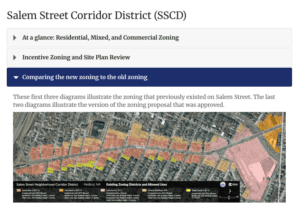Who is a member?
Our members are the local governments of Massachusetts and their elected and appointed leadership.

Medford’s new comprehensive zoning webpage contains extensive information about the process and about individual proposals.
After beginning a comprehensive, citywide zoning review — a process that started in 2022 before picking up steam last year — the city of Medford has launched a new zoning webpage with explanatory information about zoning and the review process, as well as each zoning proposal and timelines.
The zoning webpage, a result of a joint effort between City Council leadership, the city communications office and zoning consultant Innes Associates, will be updated throughout the zoning overhaul process, which will continue through the end of June. Visitors can view maps and overlays, as well as public meeting documents and meeting recordings, for each proposal.
“This has been a really awesome opportunity for the council and the city to work together to see the type of information that the community was really asking for and to give us an opportunity to say let’s respond as best as we can,” said City Council Vice President Kit Collins, who’s chair of the council’s planning and permitting committee.
Collins said the zoning overhaul work began in earnest last year after the city selected a zoning consultant, but the work had started before she joined the council in 2022, with technical updates and modernization of existing zoning ordinances laying the groundwork.
“This is an opportunity to manifest the goals of our comprehensive plan, our housing production plan, our climate action and adaptation plan,” Collins said.
The council has approved plans for the Mystic Avenue Corridor District, Salem Street Corridor District and a Green Score rubric that updates and modernizes the waivers, rewards and incentives that the city can extend to building developers to get them to meet climate resiliency and environmental standards that they’re making in projects.
Collins said the community’s appetite for more information and engagement has grown as the zoning project has moved along, and the council leadership and communications team came together late last year to determine how to make engagement as easy as possible. The communications team worked over the first two months of the year to build a framework while the city council leadership and zoning consultant drafted extensive materials to populate the webpage, with the goal of having a resource for the community where it would be hard to miss when the next public meeting is, or FAQs, as well as “five second” and “five minute” explainers for the proposals.
“Zoning is inherently technical and wonky and confusing,” Collins said. “It makes sense that it’s really hard for people to break into it. … As we work on this more, people are saying, ‘We’re not scared off by this. We want more and more information about this.’”
Language around zoning can be opaque and daunting, so Collins said it was important to make it as accessible as possible — because what they’re talking about is shared goals for the community.
“It all comes directly from these plans and visions for the community that have been built out of community feedback and input over the course of years,” she said.
The webpage also provides an opportunity for collaboration for different voices and teams within City Hall, Collins said, and has created a resource that will remain valuable even when the zoning overhaul process is done.
“This whole process, the zoning and the communications, has also driven home the importance of not just funding and resourcing and empowering zoning and the updating process, but also funding and empowering the municipal communications capacity,” Collins said.